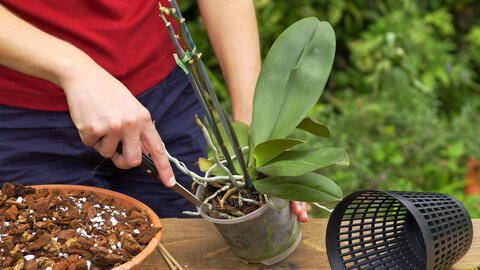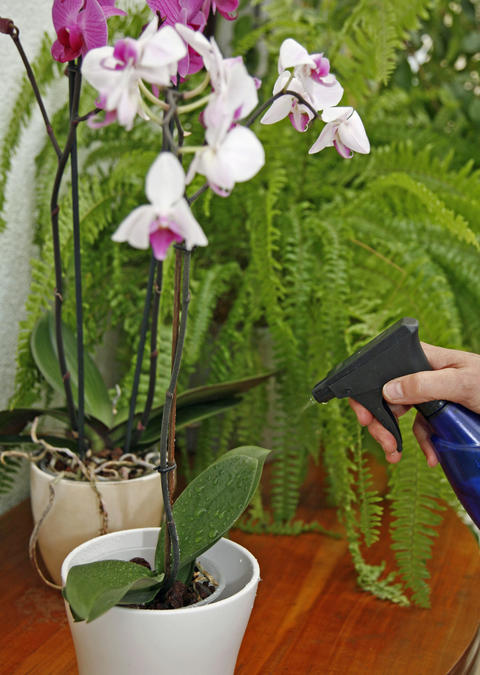Orchid Pots: Why these exotic plants need special plant pots
Many Orchids grow in unusual habitats in the wild. So it’s no wonder that these sophisticated beauties have high standards when it comes to pots. Let’s take a look at ideal pots for Orchids.

Exotic Orchids require special nursery pots and outer pots to thrive
The Orchid family (Orchidaceae) features incredible diversity: there are around 1,000 genera, over 30,000 species and thousands of varieties and hybrids. Thanks to their unique flowers and shapes, they are considered the queens of the flower world - and they behave accordingly. Around 70 percent of Orchids are air plants (epiphytes), so they grow on trees in their natural tropical forest habitats. They often root in small humus deposits in the forks of huge tree branches, taking the water they need from the frequent precipitation.
Orchids can be split up into two growth categories. Monopodial Orchids feature a single stem that grows from the top, which should be planted in the center of the pot. Sympodial Orchids branch to form multiple subsequent stems. These should ideally be planted with the oldest stems around the edge. This means that new stems will have enough room over the next year.
As Orchids are often kept by orchid lovers, collectors and experts that really throw themselves into the material, there are various tips and guides on which pot is suitable for which Orchid. The most important rules:
one orchid that doesn’t require lots of thought about the right pot is the Phalaenopsis, which is also one of the most popular indoor orchids. Also known as Moth Orchids, these floral beauties thrive in almost any standard pot in the right special aerated substrate.
Clay Orchid pots can also be used for these exotic plants. Some swear by them as the material is porous, so the helps the plant regulate its moisture balance. Waterlogging is very rare in clay pots, as a good amount of the water evaporates.
Plastic pots have become widely accepted for growing orchids on windowsills. These have multiple drainage holes in the bottom, and it’s easy to add more drainage in the base of the pot using a drill or hot wire. What’s more, it’s easier to remove the plant to repot when growing Orchids in plastic pots. Simply hold it upside down and press on the soft sides a little - and the plant will soon slip out.
Clear plastic Orchid pots are particularly popular and widespread. These let you keep a close eye on the plant’s roots without having to disturb the Orchid in any way. Whether it’s a disease, too much water or even pests: you can see what’s going on. The theory that clear pots have a positive impact on Orchid root growth as they let light through is disputed - when potted Orchids are placed in an opaque decorative pot, they do not display obviously poorer growth than those left on saucers on the windowsill.
Large Orchids, such as those in the Cattleya or Dendrobium genera, are very intolerant of moisture on their roots, so need very good root ball ventilation. Ideal Orchid pots for these species are the same plastic baskets that are used for pond plants. Otherwise, you will have to manually check that the root ball is fully dry after each watering.
Other Orchids trail as they grow or let their inflorescences grow downwards. Examples include Orchids from the Brassia, Stanhopea, Gongora and Coryanthes genera. For these, we recommend hanging baskets or hanging pots with holes. You can make these yourself using sticks, buy kits to make your own, or simply buy them ready-made. One disadvantage of hanging planters with holes is that Orchids kept indoors will dry out more quickly, so will need to be watered or misted more frequently.

Classic outer pots for Orchids are usually made from thick ceramic as this material helps to control the root ball’s temperature. They are narrow and tall with a step around one inch tall at the base. This raises the inner pot, ensuring that there is some distance between the base of the inner pot and the base of the outer pot. This lets the Orchid substrate drain well after watering so that the roots are never left in water. If you use these Orchid pots, you should pour out any remaining water around one hour after watering your orchids. Moth Orchids and other epiphytic orchid species that don’t need quite as much light and air grow very successfully in these outer pots.
Orchids need a new pot around every two years. You can repot these exotic plants during the whole growth period (early spring to summer) as the plants are forming fresh roots and will quickly outgrow the substrate.
You can spot when your Orchid needs a new pot
- if the substrate develops algae, turning green or yellow,
- if the roots have a white coating of fertilizer salt,
- if pests such as mealybugs appear,
- if the substrate has decayed or smells bad,
- if the Orchid’s growth has been slow for a while
- or if the pot has become too small and the Orchid’s roots are beginning to push out of the pot.
One more thing: when planting or repotting Orchids, you should sterilize your tools and the plant pot to avoid transferring any pathogens like viruses and bacteria. You can, for example, dunk knives and shears into methylated spirits.






